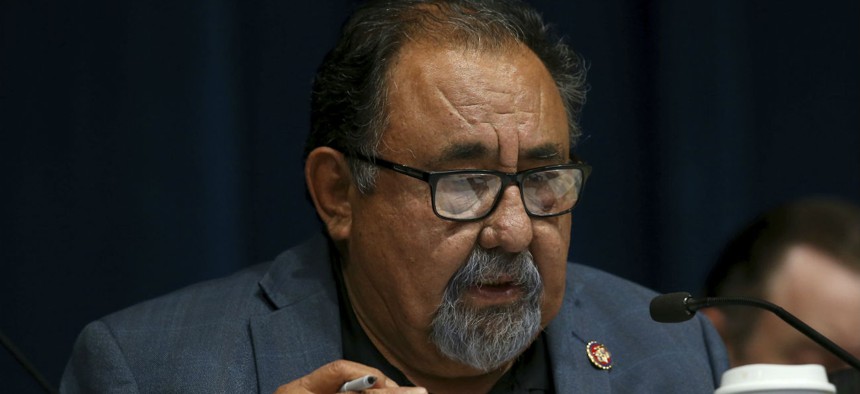
Rep. Raúl Grijalva, D-Ariz., said the Trump administration never turned over a cost-benefit analysis to justify the move. Ross D. Franklin / AP
Interior Appears Likely to Receive Funding for Relocation Even as Top Watchdog Announces Investigation
Congressional committee to subpoena records from BLM that justify moving hundreds of employees.
The federal government’s top watchdog is launching an investigation into the Trump administration’s decision to move the Bureau of Land Management’s headquarters out of Washington, as lawmakers are planning to subpoena more documents to support the relocation.
Despite the push for more information, lawmakers opposed to BLM’s move to western Colorado appeared resigned to its inevitably just one day before impacted employees must notify the agency if they plan to accept their mandated relocations. Members of Congress are still pushing for appropriators to intervene and resist the relocation, but are willing to provide funding in exchange for more information they say will enable proper oversight.
The Trump administration has never turned over a cost-benefit analysis or other documentation the Interior Department used to justify the move, Rep. Raul Grijalva, D-Ariz., who chairs the House Natural Resources Committee, said on Thursday, adding administration officials claiming they have provided key records to Congress are not being truthful.
“If we can get disclosure as a consequence, as a condition of funding, that would be important,” said Grijalva, who added he has been in discussions with appropriators to push for that contingency. “If all else fails,” he said, appropriations language requiring more information on the relocation in exchange for funding it “would be acceptable.”
The chairman explained he had to remain cautious that withholding funding would not have the intended effect of blocking the move but instead punish individual employees by preventing them from receiving the relocation incentives Interior has otherwise said it would offer. Interior previously said it would provide employees who agree to move 25% of their base salaries, as well as free temporary housing in their new locations, but has subsequently threatened to withdraw those perks if Congress blocks funding.
BLM delivered official “management directed geographic reassignments” to about 160 employees last month, giving them until Dec. 12 to decide if they will accept. BLM employees have told Government Executive they know of very few colleagues who plan to relocate, and even some of those who do are still looking for jobs in Washington and will come back home as soon as possible. Many employees have already found new jobs and left the agency. The workers all suggested morale at the Washington office has plummeted, mistrust of leadership has grown and a sinking feeling that the Trump administration is seeking to sideline important work has set in.
While employees have until the end of the day Thursday to make their decisions, stakeholders expect it will be a low number. Henri Bisson, former BLM deputy director, predicted on Wednesday based on his conversations with current employees the acceptance rate could be as low as 15%.
Grijalva called on Interior to make all impacted BLM employees available to the Government Accountability Office for its upcoming review. He said the audit itself would force the agency to “think twice” before going through with the relocation.
“If this administration is confident this move is defensible, GAO should have no problem confirming it,” Grijalva said, adding oversight remains critical even if it takes place after the fact.
In January, his committee will issue a subpoena for the records it is seeking related to relocation justification.
“We have to pursue [the subpoena],” Grijalva said. “This is one case in which the role of the committee, and the jurisdiction and its oversight function, has basically been thwarted and we feel we have more than enough ample reason to pursue it.”
Interior has defended the move by highlighting that nearly all of the land BLM manages is in western states, so it makes sense for the decision-makers to be there too. Additionally, Trump administration officials have said the move will lower lease payments, reduce travel costs and generate savings by paying employees smaller cost-of-living locality rates. Employees and other critics of the plan, however, have noted that about 97% of BLM’s workforce is already located in the western United States. Relocating employees out of Washington will make enforcement actions carry less weight, they said, and reduce the influence BLM has within Interior and the rest of the administration.
Bob Abbey, a former BLM director, said on Wednesday that in a twist of irony, the relocation will lead to more decision-making coming from political appointees in the Interior secretary’s office, rather than career experts in the field.
“The bottom line in contrast to the rhetoric coming from political appointees at the Department of Interior is this: this relocation and likely loss of dedicated public servants who will choose not to move will create a vacuum of leadership, experience and information that will take years for the Bureau of Land Management and the Department of Interior to overcome,” Abbey said.
Despite their misgivings, lawmakers expressed a sense there was no way to stop the relocation from moving forward. Rep. Deb Haaland, D-N.M., said she and her colleagues have to “make sure this blatant abuse of authority isn’t repeated.”
“We always have to fight as hard as we can until we can’t any longer,” Haaland said.
NEXT STORY: Analysis: Impeachment Gets Weird







